If you like this article, read more about Milwaukee-area history and architecture in the hundreds of other similar articles in the Urban Spelunking series here.
Belly up to these bar stories, brought to you by Miller Brewing Co., that explore well-loved but lesser-known taps and taverns from all corners of the city and beyond.
Seriously, the "Cheers" reference is a tired one, but the idea of a third place where you’re so comfortable and well-known that it feels like being among friends in your own home remains so powerful that we all just keep coming back to it.
That’s how I feel about Club Garibaldi, 2501 S. Superior St., a place I first stepped into at some point in the 1980s when a band I was in played some gigs in the back room, unknowingly joining a dance hall tradition at the Bay View corner tap that runs back into at least the 1920s.
Now, I own the place. Well, not really. The Italian-American Mutual Aid Society Giuseppe Garibaldi – an immigrant mutual aid society, founded in 1908, that provided insurance at a time when few possessed such a luxury, and brotherhood – owns the building, and as a member, I am therefore technically one of the many owners. (Disclaimer: Despite the fact that I am a past president whose photo hangs amid the back wall pantheon of others who’ve held that position over the past 115 years, I receive no financial benefit from this "ownership," nor do I have any unilateral power over the place.)
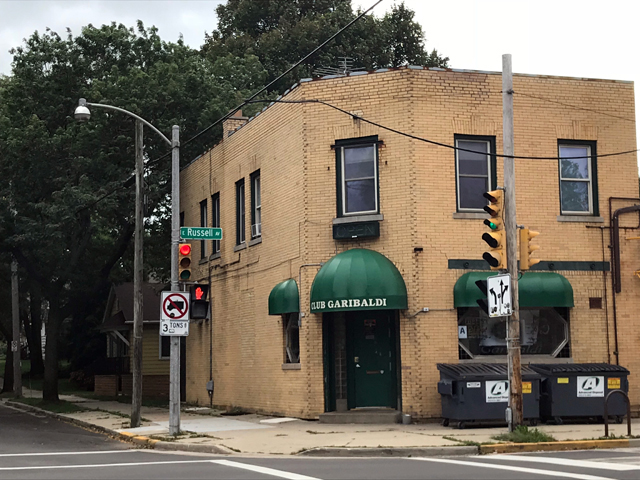
The bar is leased to Joe Dean, who has occupied the space for the past 18 years, serving some of the city’s best wings (Wednesday is wings day!) and helping to maintain a friendly neighborhood tap vibe. Kinda like the bar on "Cheers."
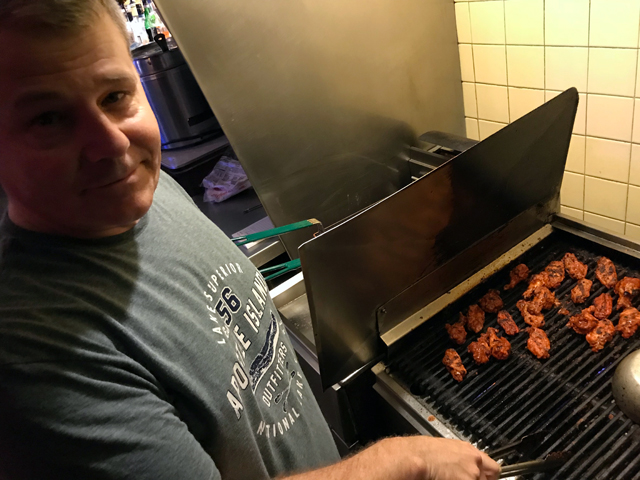
"Weekend nights we're a music venue, Wednesdays a restaurant, weekdays a classic corner tavern," says Dean. "I've tried to keep the place a neighborhood corner tavern, partly to keep the history going, but also given the changes in the neighborhood demographic, it gives people a place to go that doesn't cater to just one part of the neighborhood."
Everyone comes to Garibaldi, as Dean suggests. Pop in on a weeknight and you’ll see guys in suits on their way home from work alongside folks in blue collar work clothes. You’ll see people in indie band tees and, really, just about everyone, young and old, from the area.

The tavern area has a great back bar with dark, age-worn wood, an etched mirror, scalloped glass and studded leather. There’s a tiny grill back in the corner from whence those magical wings and other food astonishingly emerge.
Through the double swinging doors, you find the hall, where the Society meets monthly, where concerts happen on various nights, where folks shoot pool, where a disco ball holds center court, where gorgeous 1920s tile adorns the wall and where, on the western wall, you can see those stoic Italian faces of most of the past Garibaldi presidents.
A little history
Mirroring the history of man, the more recent decades of Club Garibaldi history are well-enough documented, presenting little mystery. But attempt to get at the earliest of days and, well, good luck.
The Wisconsin Historical Society and City of Milwaukee websites suggest the dawn came in 1907, but we know better, don’t we?
In fact, a quick newspaper search and a stroll back through time via Milwaukee city directories show taverns operating on that corner as far back as 1888, when Richard Seward began tapping kegs.
In the early 1890s, Hans Grey followed on the heels of barkeep Theodore Franke. James A. Kerr – a Scotsman who, for a time, ran three bars in the area, along with ones at 838 E. Linus (now a private home) and 2414 S. St. Clair (now Three Brothers) – followed by 1894 and remained until 1903, when James Elliott took over and stayed nearly 20 years.
And it’s here where things become quite interesting.
In 1907, beer magnate August Uihlein tapped architect Charles Lesser, who did much of the Schlitz work in the first decade of the 20th century, to design a new Schlitz tied house for the site. Similar Lesser designs were built on 27th and Lisbon and on 6th and Bruce.
But what happened to the earlier building? Well, despite much searching, I can’t find any official documentation, though there are some good clues.
City permits for the address date back only to 1922, so it is possible that the 1907 building was an adaptation of the existing building, though by judging from shapes seen on Sanborn Fire Insurance maps, that seems unlikely.
The Wisconsin Historical Society’s Architecture Inventory suggests a much more intriguing explanation.
The WHS entry for the nearby Cactus Club (2496 S. Wentworth Ave.) reads, "moved to present location in 1907 for $600. Moved to make room for construction of current Club Garibaldi." That creates a fun tie for two neighboring neighborhood corner taps that offer some of the best live music in town.
But is it true?
First off, there is no detailed source named on the WHS site for the information on the alleged building move.
The 1894 Sanborn map shows a structure already on the site on the current Cactus Club and the shape of that building is basically the same as that of the one that stands there today.
City directories haven’t helped much, though there are no listings for a tavern at the Cactus address before 1907. While that seems like evidence in support of the move, it may also simply be possible (and likely) that the building existed but wasn’t used as a bar until then.
City directories of that era do not have address look-ups, as later ones do, and it’s nearly impossible to scour the books’ hundreds and hundreds of pages for a specific address, so I went to the deeds office at the County Courthouse, but, while interesting, those documents showed no sign I could find of the building move.
None of the names associated with ownership or rental of one property appeared in the records of the other.
However, comparing the 1894 maps and the 1910 maps, it appears possible – and perhaps even likely – that the building was indeed moved across the street. But it did not replace the earlier building.
Check out the part of the building that is the Cactus Club's back room. It is a single-story structure of about the same size as the building shown on the corner of Superior in 1894.
To my eyes, it looks as though the building were moved across the street, turned 180 degrees and attached to the back of the existing tavern facing Wentworth.
I love that there's an interesting connection between these two Bay View landmarks.
The "Dago Pete" era
If you want interesting, then the era when Joseph Paolo, inexplicably AKA as "Dago Pete," is what you want to know about.
The rumors about rum-running at Club Garibaldi – then called Paradise Gardens – are true.
According to one newspaper report, Paolo had "been a character in the night life of the city" since the mid-1910s.
"He was particularly widely known on the south side. He was manager of the Idlewild Club, Packard Avenue, Town of Lake, and first became notorious and wealthy as the owner and operator of the Paradise Gardens, near the city limits. He was at one time said to be worth a ‘hundred grand,’ the parlance of the gangs for $100,000."
In 1920, with Prohibition in force, Schlitz sold the Superior Street tavern to Paolo, who, theoretically, ran a soft drink parlor and dance hall there featuring performances by the likes of Bob’s Navy Club Orchestra, among others.
By 1921, Paolo’s place was one of 99 in the city included on a police watch list.
"In his first ‘blacklist’ submitted to the council, (new) Chief of Police (Jacob) Laubenheimer ‘objects’ to licenses being issued to 99 saloon keepers and reports that 50 others have to agreed to quit business," the Journal wrote.
Paradise Gardens was on the list, but it seems to have continued unabated.
The following year, Paolo built a garage on the property and in 1927, he remodeled the building and added the hall to the west side, digging a basement for it, too. But he might’ve had other plans for the basement, beyond its service as a solid foundation for the hall.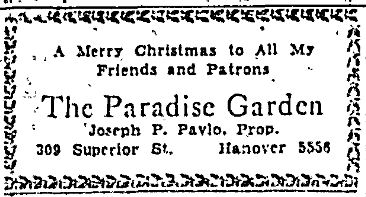
Also in ‘27, federal agents raided the place – which for a brief time was called The Tourist Inn – along with John Ermi’s place across the street (now home to Palomino). At Paradise Gardens they found "two big casks and nine barrels of wine, two half barrels of beer and 30 gallons of beer in process of manufacture."
Paolo seemed to shake it all off. In ‘28, Paradise Gardens was still going strong, though it faced a judgement in a lawsuit by bandleader Ralph Knolla of Knolla’s Orchestra, who had cast himself out of Paradise Gardens for a gig at Blue Heaven roadhouse out on the Green Bay Road, and said Paolo still owed him money.
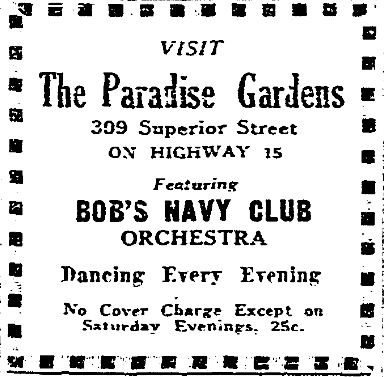 Knolla was not alone. In December of that year and the following January, deputies raided Paradise Gardens three times attempting to collect money to pay Paolo’s outstanding debts.
Knolla was not alone. In December of that year and the following January, deputies raided Paradise Gardens three times attempting to collect money to pay Paolo’s outstanding debts.
Around this time, it appears Paolo and his wife Josephine were on the outs, too. She later complained that her husband was a philanderer and had lavished tens of thousands of dollars on a floozy he met at another roadhouse.
In 1929 Paolo sold Paradise Gardens to Hans "John" Roedel, but the trouble did not end for "Dago Pete."
In 1930, he sprayed sprayed an area roadhouse with bullets and was fined for carrying concealed weapons and for speeding.
Early in the morning of Feb. 27, 1931, in the words of the Journal, "Paolo, 43, a roadhouse proprietor with a police record, was ‘put on the spot,’ Chicago fashion ... and shot, dying almost instantly in front of the pool hall of Mike Delsano on East St. Francis Avenue, near South Ellen Street, half a block south of the city limits."
Paolo had argued with a couple men in the pool hall – about "tribute" money Paolo said Loffredo owed him, according to Gavin Schmitt – and when the men left, Paolo followed them outside. They shot him in the street as they drove past, and away, in their car. A witness of interest to the police was waitress "Flo" Walker (whose real surname was Wangerin), the woman that Josephine had complained about.
In April of that year, "Cross-Eyed" Jack Loffredo – described in one newspaper report as a "Chicago alcohol runner" – was convicted of killing Paolo.
"Perhaps most interesting," wrote Schmitt on his website, "Josie Paolo sat side by side in the courtroom with Flo Walker, Pete’s mistress, as they comforted each other."
In an interesting coincidence, Loffredo was the son of Leonardo and Antonia Loffredo, who operated the tavern on St. Clair that is now the Cactus Club around the time that it may or may not have been moved from the site of where Paolo's former Paradise Gardens stood.
Loffredo was pardoned in 1934 by Gov. Albert G. Schmedeman. Loffredo's father, Leonardo, was gunned down outside his tavern in 1910 after an argument with a neighbor.
In the basement of the bar, there are some things that appear to remnants of this era of the Paradise Gardens.
There's the giant old-time safe that when opened a few years ago proved to be much like the opening of Capone's vault. That's to say, it was basically empty.

Nearby, attached to the ceiling is a switch that Dean thinks served as a warning buzzer. And, along the north foundation wall there were once openings – now sealed – that led into a passage that some elderly neighborhood residents said led across to John Ermi’s tavern (Palomino) across Russell Street and out to Lake Michigan.
Ask Dean and he's happy to share the stories old timers have told him over the years about the rum-running days in the heart of old Bay View.
Paradise, post-Paolo
With Hans Roedel now at the helm, Paradise Gardens held a Grand Opening on Aug. 31, 1929 and kicked off its fall season on Oct. 26 and hosting a Halloween Night bash (no cover charge!). And the music kept coming.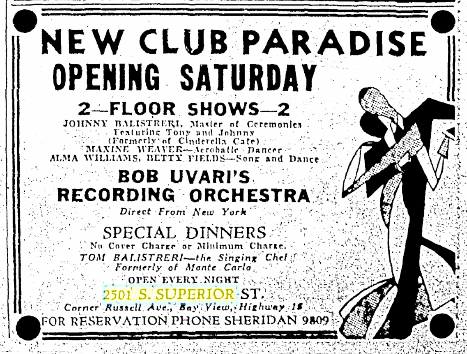
In early 1930, Roedel advertised music, dancing and refreshments every night. Dixie’s Vagabonds were regulars onstage in the back room, as were, later, Bob Uvari’s Recording Orchestra and Tom Balistreri, "The Singing Chef."
That December, with no apparent change in ownership, Paradise Gardens held another grand opening "under new management." Maybe the legend of "Dago Pete" was so strong that Roedel had to work hard to shake free of it.
Perhaps because he was ill, Roedel – who continued to own the building – decided to lease the bar. In 1934 Ralph Wettestein applied for a tavern license but disappeared before it could be issued.
Instead, the Paradise Music Hall briefly became the domain of Walter Eggert, who lived in the apartment upstairs, until he was replaced in September 1935 – a couple months after Roedel’s death – by George Mangino.
In 1939, Alex Pagliasotti moved into the apartment and ran the bar, marking what could be a key to the Garibaldi connection. Pagliasottis were among the pioneers of the society, which got its start at padrone Giuseppe Gardetto’s tavern and rooming house, 2423-27 S. St. Clair St., and later, after a falling out with Gardetto, moved its meetings to Puddler’s Hall up the street.
 A couple years later, Harold Wesela took over, renaming the place Harold Wesela’s Paradise and offering "hamburgers and steaks" and "dancing on Friday, Saturday and Sunday with Bert Bailey and His Brown Buddies."
A couple years later, Harold Wesela took over, renaming the place Harold Wesela’s Paradise and offering "hamburgers and steaks" and "dancing on Friday, Saturday and Sunday with Bert Bailey and His Brown Buddies."
Wesela was quick to find trouble, however. Five days before the bombing of Pearl Harbor, the Journal reported that, "a formal complaint urging revocation of the tavern license issued to Harold G. Wesela, operator of the Paradise Gardens, at 2501 S. Superior St., was filed with the common council Tuesday by Police Chief Joseph Kluchesky. The complaint pointed out that Wesela was convicted as keeper of a disorderly house Nov. 25 and fined $100 and costs in the district court after police had raided the place during a stag party. Even though the offense against Wesela was his first, Kluchesky apparently regarded it as sufficiently serious to require revocation."
The Garibaldi era
In early 1943, Hans Roedel’s widow Margaret sold the Paradise Gardens building to the Italian American Mutual Aid Society Giuseppe Garibaldi, which in addition to providing benefits and fellowship to its members had by then become a respected neighborhood civic organization.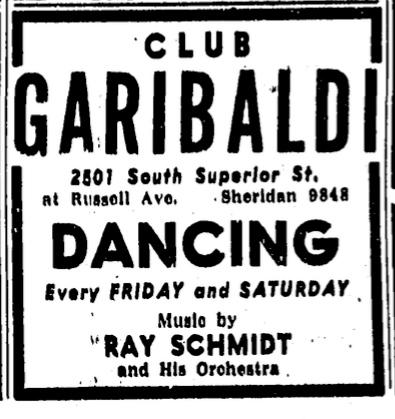
And, still, under the new ownership, the music continued. You could hear Ray Schmidt and His Orchestra there in 1944, for example.
By the early ‘50s, the Society was seeking a lessee to run the tavern, advertising the place in classified ads: "fully equipped tavern. All-brick building. Beautiful! Large dance area which seats over 300 people. Yes, a roomy flat for owner. Excellent location."
 One Jim Jendusa snapped it up and tinkered it. In addition to live music – Joe Pitzo and His Orchestra – Jendusa served fish fry, spaghetti, seafood and fried chicken and advertised itself as "Bay View’s Only Pizza Spot."
One Jim Jendusa snapped it up and tinkered it. In addition to live music – Joe Pitzo and His Orchestra – Jendusa served fish fry, spaghetti, seafood and fried chicken and advertised itself as "Bay View’s Only Pizza Spot."
Jimmy Bontempo replaced Jendusa once the freeway erased his Shell gas station on State Street, according to one of his nephews, and he was replaced by Florence Schneeberg and Delores Fenney, who called the place "The New Club" for a while. In ‘78 Robin D’Amato was running the place, followed by Acim "Sam" Selimi in the ‘80s and, later, Robert Buckley.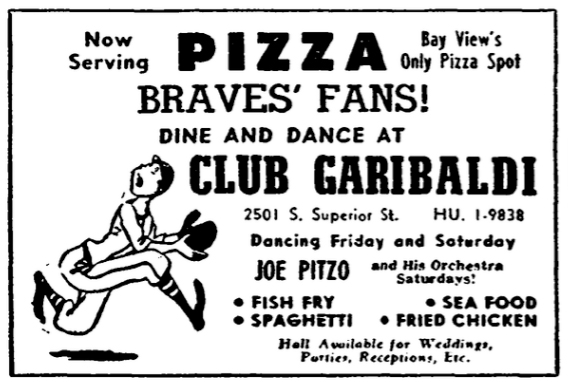
There was some music during this era, but Club Garibaldi wasn’t as dance-focused as it had been back in the live music and dancing heyday.
Dean took over in 2000 with then-partner Tag Grotelueschen and brought the music back to the back room, building a proper stage in one corner, adding a good sound system and adding a sound booth, too.
It remains a great place for a beer, for food and for live music. And as long as Dean is around – and working alongside the Garibaldi Society – Club Garibaldi will honor its history.

Club Garibaldi, 1980. (PHOTO: Wisconsin Historical Society)
"As far as renting from the Garibaldi Society, it is a unique arrangement," he says.
"It makes me feel that in a small way, l have added to the history of the society, as well. I have been renting from the society for 18 years and hope to be here another 18, if they'll have me. We have worked together to restore the luster to this great old building, which is a source of pride for both myself and the members here."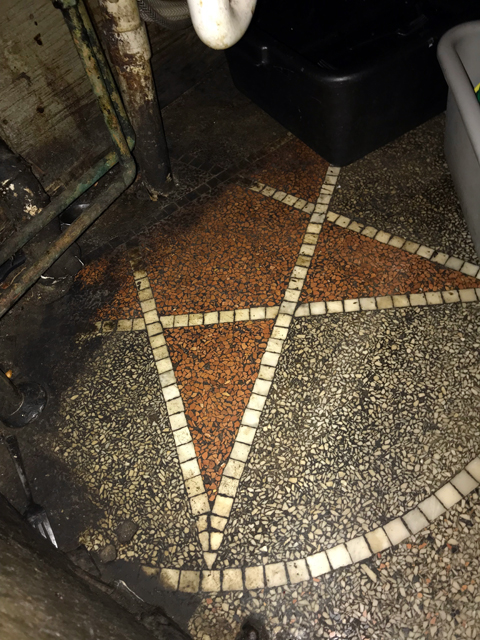
Dean can show you some interesting old details, like the terrazzo floor that clearly shows that the bar area was once laid out quite differently. A red and white terrazzo and tile five-pointed star, for example, now sits obscured, half beneath the bar.
"Keeping the history alive is more important than ever now days," he says, "where every day we seem to have a piece of neighborhood history torn down to make way for upscale condos and apartments."
Born in Brooklyn, N.Y., where he lived until he was 17, Bobby received his BA-Mass Communications from UWM in 1989 and has lived in Walker's Point, Bay View, Enderis Park, South Milwaukee and on the East Side.
He has published three non-fiction books in Italy – including one about an event in Milwaukee history, which was published in the U.S. in autumn 2010. Four more books, all about Milwaukee, have been published by The History Press. A fifth collects Urban Spelunking articles about breweries and maltsters.
With his most recent band, The Yell Leaders, Bobby released four LPs and had a songs featured in episodes of TV's "Party of Five" and "Dawson's Creek," and films in Japan, South America and the U.S. The Yell Leaders were named the best unsigned band in their region by VH-1 as part of its Rock Across America 1998 Tour. Most recently, the band contributed tracks to a UK vinyl/CD tribute to the Redskins and collaborated on a track with Italian novelist Enrico Remmert.
He's produced three installments of the "OMCD" series of local music compilations for OnMilwaukee.com and in 2007 produced a CD of Italian music and poetry.
In 2005, he was awarded the City of Asti's (Italy) Journalism Prize for his work focusing on that area. He has also won awards from the Milwaukee Press Club.
He has been heard on 88Nine Radio Milwaukee talking about his "Urban Spelunking" series of stories, in that station's most popular podcast.



%20copy.jpg)

